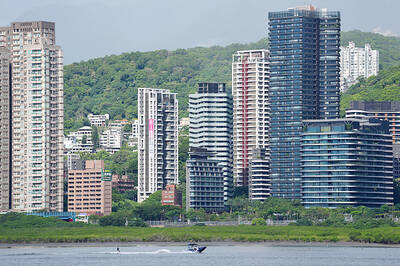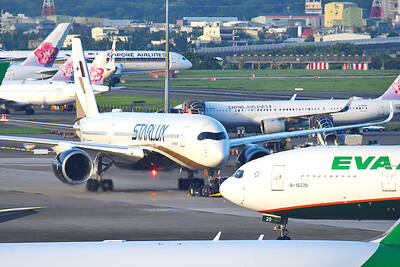Minister of Economic Affairs Kung Ming-hsin (龔明鑫) yesterday said the ministry has contacted the Taiwan Electrical and Electronic Manufacturers’ Association to explore ways to support the association’s proposal to establish technology parks in Mexico, Poland, India and the Philippines.
The ministry has set up trading centers in the Czech Republic, Japan, the US and other markets to help local manufacturers deploy strategically, and would assist them in establishing operations in the countries, Kung told a news conference in Taipei.
However, he downplayed concerns that local manufacturers’ expansions overseas would reduce their operations in Taiwan.

Photo: CNA
The expansions are not industrial relocation, but extensions of firms’ capacity and capabilities, Kung said, adding that the Department of Investment Review would closely monitor the situation.
The ministry would also help Taiwanese manufacturers secure orders from non-US markets to counter high US tariffs, with more opportunities in Europe, Japan, India and South Asia, he said.
Although uncertainty remains about the US’ semiconductor tariff rates pending the outcome of a Section 232 investigation under the US Trade Expansion Act of 1962, Taiwanese chipmakers had already started investing in the US well before tariff talks between Taipei and Washington to ensure smoother operations, he said.
Regardless of the tariffs, the robust demand for artificial intelligence products and high-end servers, and the investments in the technologies by Taiwanese firms, coupled with the government’s policy support for silicon photonics, quantum computing and robotics, would bode well for Taiwanese industries, he added.
Separately, Kung said that state-run Taiwan Power Co (Taipower, 台電) would strive to keep the power grid’s nighttime reserve margin above 6 percent following a fire at Taipower’s Hsinta Power Plant (興達電廠) in Kaohsiung on Tuesday last week and a malfunction at the coal-fired Linkou Power Plant (林口電廠) in New Taipei City on Monday.
The reserve margin, which ensures supply during disruptions such as malfunctions or fires, should exceed 10 percent during the day, while Taipower would keep it above 6 percent at night, he said.
Taipower chairman Tseng Wen-sheng (曾文生) said that it would keep the reserve margin above 6 percent during peak nighttime hours through the end of this month after the deployment of backup units.
While the power supply remains sufficient, pressure remains on the grid due to scheduled repair and maintenance of major generators, he said.
The power supply would further stabilize if a new generator at Hsinta Power Plant resumes operation next month, he added.
Last week’s and Monday’s incidents cut 2.1 gigawatts of power generation, Tseng said.

Taiwan’s rapidly aging population is fueling a sharp increase in homes occupied solely by elderly people, a trend that is reshaping the nation’s housing market and social fabric, real-estate brokers said yesterday. About 850,000 residences were occupied by elderly people in the first quarter, including 655,000 that housed only one resident, the Ministry of the Interior said. The figures have nearly doubled from a decade earlier, Great Home Realty Co (大家房屋) said, as people aged 65 and older now make up 20.8 percent of the population. “The so-called silver tsunami represents more than just a demographic shift — it could fundamentally redefine the

The US government on Wednesday sanctioned more than two dozen companies in China, Turkey and the United Arab Emirates, including offshoots of a US chip firm, accusing the businesses of providing illicit support to Iran’s military or proxies. The US Department of Commerce included two subsidiaries of US-based chip distributor Arrow Electronics Inc (艾睿電子) on its so-called entity list published on the federal register for facilitating purchases by Iran’s proxies of US tech. Arrow spokesman John Hourigan said that the subsidiaries have been operating in full compliance with US export control regulations and his company is discussing with the US Bureau of

Businesses across the global semiconductor supply chain are bracing themselves for disruptions from an escalating trade war, after China imposed curbs on rare earth mineral exports and the US responded with additional tariffs and restrictions on software sales to the Asian nation. China’s restrictions, the most targeted move yet to limit supplies of rare earth materials, represent the first major attempt by Beijing to exercise long-arm jurisdiction over foreign companies to target the semiconductor industry, threatening to stall the chips powering the artificial intelligence (AI) boom. They prompted US President Donald Trump on Friday to announce that he would impose an additional

China Airlines Ltd (CAL, 中華航空) said it expects peak season effects in the fourth quarter to continue to boost demand for passenger flights and cargo services, after reporting its second-highest-ever September sales on Monday. The carrier said it posted NT$15.88 billion (US$517 million) in consolidated sales last month, trailing only September last year’s NT$16.01 billion. Last month, CAL generated NT$8.77 billion from its passenger flights and NT$5.37 billion from cargo services, it said. In the first nine months of this year, the carrier posted NT$154.93 billion in cumulative sales, up 2.62 percent from a year earlier, marking the second-highest level for the January-September